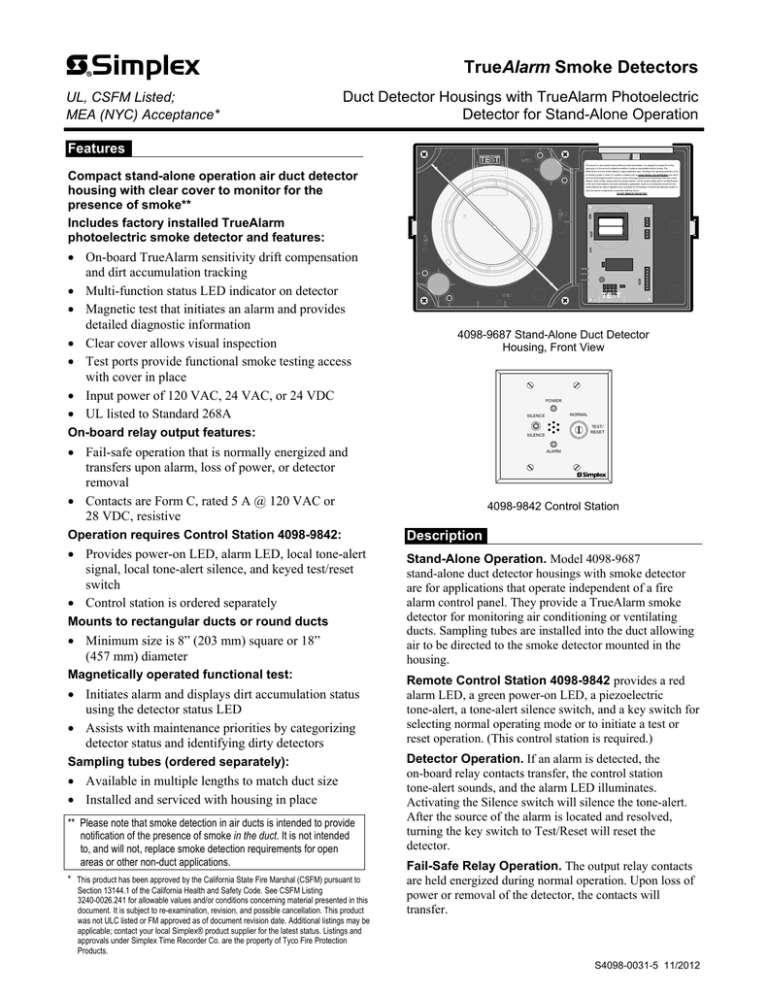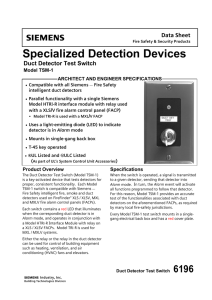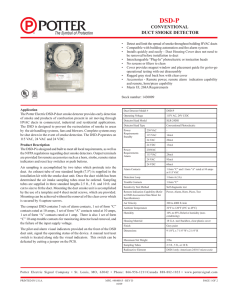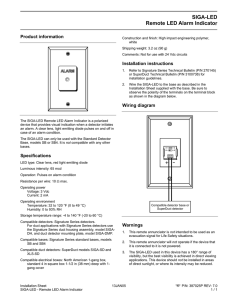
TrueAlarm Smoke Detectors
UL, CSFM Listed;
MEA (NYC) Acceptance*
Duct Detector Housings with TrueAlarm Photoelectric
Detector for Stand-Alone Operation
Features
This device is a duct smoke housing. When provided with detector, it is designed to sample the air flow
passing by it in the air duct to determine whether it contains unacceptable levels of smoke. The
effectiveness of a duct smoke detector is highly dependent upon: the design and operating conditions of the
air handling system in which it is installed, variables such as smoke dilution and stratification over which
even the best designed systems have no control, and proper placement and positioning of the duct smoke
detector, which is often compromised for practical reasons. For the reasons stated above, the effectiveness
of this duct smoke detector cannot be warranted or guaranteed. Under no circumstances should this duct
smoke detector be used or regarded to be a substitute for the building's Fire alarm and detection system to
which this device is attached as a secondary detection device.
DO NOT REMOVE THIS NOTICE!
Compact stand-alone operation air duct detector
housing with clear cover to monitor for the
presence of smoke**
Includes factory installed TrueAlarm
photoelectric smoke detector and features:
On-board TrueAlarm sensitivity drift compensation
and dirt accumulation tracking
Multi-function status LED indicator on detector
Magnetic test that initiates an alarm and provides
detailed diagnostic information
Clear cover allows visual inspection
Test ports provide functional smoke testing access
with cover in place
Input power of 120 VAC, 24 VAC, or 24 VDC
UL listed to Standard 268A
On-board relay output features:
Fail-safe operation that is normally energized and
transfers upon alarm, loss of power, or detector
removal
Contacts are Form C, rated 5 A @ 120 VAC or
28 VDC, resistive
Operation requires Control Station 4098-9842:
Provides power-on LED, alarm LED, local tone-alert
signal, local tone-alert silence, and keyed test/reset
switch
Control station is ordered separately
Mounts to rectangular ducts or round ducts
Minimum size is 8” (203 mm) square or 18”
(457 mm) diameter
Magnetically operated functional test:
Initiates alarm and displays dirt accumulation status
using the detector status LED
Assists with maintenance priorities by categorizing
detector status and identifying dirty detectors
Sampling tubes (ordered separately):
Available in multiple lengths to match duct size
Installed and serviced with housing in place
** Please note that smoke detection in air ducts is intended to provide
notification of the presence of smoke in the duct. It is not intended
to, and will not, replace smoke detection requirements for open
areas or other non-duct applications.
* This product has been approved by the California State Fire Marshal (CSFM) pursuant to
Section 13144.1 of the California Health and Safety Code. See CSFM Listing
3240-0026.241 for allowable values and/or conditions concerning material presented in this
document. It is subject to re-examination, revision, and possible cancellation. This product
was not ULC listed or FM approved as of document revision date. Additional listings may be
applicable; contact your local Simplex® product supplier for the latest status. Listings and
approvals under Simplex Time Recorder Co. are the property of Tyco Fire Protection
Products.
4098-9687 Stand-Alone Duct Detector
Housing, Front View
POWER
NORMAL
SILENCE
TEST/
RESET
SILENCE
ALARM
4098-9842 Control Station
Description
Stand-Alone Operation. Model 4098-9687
stand-alone duct detector housings with smoke detector
are for applications that operate independent of a fire
alarm control panel. They provide a TrueAlarm smoke
detector for monitoring air conditioning or ventilating
ducts. Sampling tubes are installed into the duct allowing
air to be directed to the smoke detector mounted in the
housing.
Remote Control Station 4098-9842 provides a red
alarm LED, a green power-on LED, a piezoelectric
tone-alert, a tone-alert silence switch, and a key switch for
selecting normal operating mode or to initiate a test or
reset operation. (This control station is required.)
Detector Operation. If an alarm is detected, the
on-board relay contacts transfer, the control station
tone-alert sounds, and the alarm LED illuminates.
Activating the Silence switch will silence the tone-alert.
After the source of the alarm is located and resolved,
turning the key switch to Test/Reset will reset the
detector.
Fail-Safe Relay Operation. The output relay contacts
are held energized during normal operation. Upon loss of
power or removal of the detector, the contacts will
transfer.
S4098-0031-5 11/2012
Duct Detector Selection Chart
Model
Description
4098-9687
Compatibility
Stand-alone operation duct detector with internal output relay,
input power is 120 VAC, 24 VAC, or 24 VDC*
Requires 4098-9842 Test Station
(ordered separately)
Control Station (required, ordered separately)
Model
Description
4098-9842
Mounting
Use double gang box,
3” H x 4” W x 2” D
(76 mm x 102 mm x 51 mm)
Control Station with power-on green LED, red alarm LED,
tone-alert, silence switch and key switch for test/reset, on
stainless steel plate
* Stand-alone duct detector housing includes an internally mounted model 4098-9601 TrueAlarm photoelectric detector and an exhaust
tube. A correctly sized sampling tube (ordered per application) is required, refer to chart below.
Sampling Tube Selection Chart, Ordered Separately Per Duct Width, Select One
Overall Duct Width
Tube Required
Suggested Cut Length
12” (305 mm)
4098-9854
1/2” (12.7 mm) longer than duct width
13” to 23” (330 mm to 584 mm)
4098-9855
1/2” (12.7 mm) longer than duct width
24” to 46” (610 mm to 1168 mm)
4098-9856
3 in” (76 mm) longer than duct width
46” to 71” (1168 mm to 1803 mm)
4098-9857
3 in” (76 mm) longer than duct width
71” to 95” (1803 mm to 2413 mm)
4098-9858
3 in” (76 mm) longer than duct width
4098-9842 Control Station Indicator Reference
Operation Status
Normal
Alarm
Trouble, missing detector head
Trouble, power fail
Power-On LED
On
Off
Alarm LED
Off
All On
On
All Off
Tone-Alert
Off
Control Relay
Coil energized
On
Coil de-energized
TrueAlarm Detector Status LED Indications
LED Indication
Status
Pulses approximately every 4 seconds
Normal
Steady On
Alarm
Detector LED Response to Magnetic Test **
LED Indication
Followed By
LED turns ON
Alarm is initiated
Normal, sensitivity is within
compensation range
Alarm is initiated
More sensitive, out of normal
compensation range
LED pulses quickly,
6 times in 3 seconds,
then turns ON
LED pulses slowly,
4 times in 8 seconds,
then turns ON
Status
Action
None
Cleaning or other
service is required
Less sensitive, out of normal
compensation range
Alarm is initiated
Detector is malfunctioning
Does not initiate Alarm
Service is required
** Testing requires placing a magnet at the designated location on the duct housing cover for 4 seconds and referring to the response from
the red LED status indicator on the detector. Refer to Installation Instructions 574-777 for further test and maintenance information.
2
S4098-0031-5 11/2012
Stand-Alone Duct Detector Housing Detail Reference
NOTE: Refer to Installation Instructions 574-777 for additional detail and maintenance information.
11-3/8" (289 mm)
Exhaust tube access hole
Magnetic test area
Conduit (by others)
This device is a duct smoke housing. When provided with detector, it is designed to sample the air flow
passing by it in the air duct to determine whether it contains unacceptable levels of smoke. The
effectiveness of a duct smoke detector is highly dependent upon: the design and operating conditions of
the air handling system in which it is installed, variables such as smoke dilution and stratification over
which even the best designed systems have no control, and proper placement and positioning of the duct
smoke detector, which is often compromised for practical reasons. For the reasons stated above, the
effectiveness of this duct smoke detector cannot be warranted or guaranteed. Under no circumstances
should this duct smoke detector be used or regarded to be a substitute for the building's Fire alarm and
detection system to which this device is attached as a secondary detection device.
DO NOT REMOVE THIS NOTICE!
Status LED
Metal plate with dual holes
for 3/4" (19 mm) conduit, plug
supplied for unused hole
6-3/4"
(171 mm )
Front View
4098-9601 Smoke detector
mounted in base (supplied)
Sampling tube
access hole
120 VAC input
selection terminals
Relay output terminals
Stationary baffle (built-in)
24 VDC/VAC
input and control
station terminals
Captive fastening screws (4)
Transparent cover
Gasketed detector area
Side of duct
NOTE: Orientation shown is for reference
only, refer to General Location Notes and
End View illustration below for alternate
mounting reference.
3-3/8"
(86 mm)
Bottom view
Duct wall
13/16"
(21 mm)
4098-9842 Control Station
Exhaust tube
(supplied)
Test ports (2) provided
for measuring airflow
and for aerosol injection
Sampling tube, ordered
separately per duct width
Gaskets (supplied)
POWER
NORMAL
SILENCE
TEST/
RESET
SILENCE
Square duct
reference outline
Alternate location
(if appropriate)
18" Round duct outline
(minimum diameter)
ALARM
Sampling tube, keyed for proper hole alignment with holes facing
into airflow (template is provided for proper tube installation).
(Housing is shown as position 2 per note 2 below.)
General Location Notes:
End View with
Ducts and Tubes
2. Three duct side mounting options are available as shown below.
Mount housing at 90° to airflow for all orientations.
Arrows indicate allowed airflow directions.
1
Exhaust tube
2
3
This device is a duct smoke housing. When provided with detector, it is designed to sample the air flow
passing by it in the air duct to determine whether it contains unacceptable levels of smoke. The
effectiveness of a duct smoke detector is highly dependent upon: the design and operating conditions of the
air handling system in which it is installed, variables such as smoke dilution and stratification over which
even the best designed systems have no control, and proper placement and positioning of the duct smoke
detector, which is often compromised for practical reasons. F or the reasons stated above, the effectiveness
of this duct smoke detector cannot be warranted or guaranteed. Under no circumstances should this duct
smoke detector be used or regarded to be a substitute for the building's Fire alarm and detection system to
which this device is attached as a secondary detection device.
DO NOT REMOVE THIS NOTICE!
Duct
housing
1. Testing performed under the auspices of the Fire Detection
Institute (FDI) recommended when sampling tubes are not
located vertically, that they be positioned horizontally in the
upper half of the duct to account for possible stratification.
This device is a duct smoke housing. When provided with detector, it is designed to sample the air flow
passing by it in the air duct to determine whether it contains unacceptable levels of smoke. The
effectiveness of a duct smoke detector is highly dependent upon: the design and operating conditions of the
air handling system in which it is installed, variables such as smoke dilution an d stratification over which
even the best designed systems have no control, and proper placement and positioning of the duct smoke
detector, which is often compromised for practical reasons. For the reasons stated above, the effectiveness
of this duct smoke detector cannot be warranted or guaranteed. Under no circumstances should this duct
smoke detector be used or regarded to be a substitute for the building's Fire alarm and detection system to
which this device is attached as a secondary detection device.
DO NOT REMOVE THIS NOTICE!
8" Square duct outline
(minimum width)
This device is a duct smoke housing. W hen pr ovided with detector, it is designed to sample the air flow
passing by it in the air duct to determine whether it contains unacceptable levels of smoke. The
effectiveness of a duct smoke detector is highly dependent upon: the design and operating conditions of the
air handling system in which it is installed, var iables such as
smoke d ilut io n and stratification
o ver which
even the best designed systems have no control, and proper placement and positioning of the duct smoke
detector, which is often compromised for practical reasons. For the reasons stated above, the effectiveness
of this duct smoke detector cannot be warr anted or guar anteed. Under no circumstances should this duct
smoke detector be used or regar ded to be a substitute for the building's Fire alarm and detection system to
which this device is attached as a secondary detection device.
DO NOT REMOVE THIS NOTICE!
DO NOT MOUNT ON
BOTTOM OF DUCT
3
S4098-0031-5 11/2012
Stand-alone Duct Detector Location Reference
Duct Detector Location Considerations:
Exhaust Damper
Detector OK
Exhaust
Return Air
1.
2.
Do not locate
detector here
Return air
damper
3.
4.
Supply Air
Fresh air
Do not locate
detector here
Filter bank
5.
Detector OK
Proper duct smoke detection location must ensure
adequate airflow within the duct housing.
Duct air velocity rating is 300 to 4000 ft/min (91 to
1220 m/min). Pressure differential between intake and
exhaust tubes is required to be between 0.015 to 1.55
inches of water (0.381 to 39.37 mm).
Ensure accessibility for test and service.
Proper Locations: downstream side of filters to detect
fires in the filters; in return ducts, ahead of mixing
areas; upstream of air humidifier and cooling coil.
Other locations and orientations may be required for
proper duct smoke detection depending on duct access,
system design, and duct airflow testing. Contact your
local Simplex product supplier for assistance.
Locations to Avoid:
Additional Information. Refer to NFPA 90A, Standard
for the Installation of Air Conditioning and Ventilating
Systems; NFPA 72, the National Fire Alarm and Signaling
Code; and the NEMA Guide for Proper Use of Smoke
Detectors in Duct Applications, and Installation Instructions
574-776.
1.
2.
3.
Where dampers closed for comfort control would
interfere with airflow.
Next to outside air inlets (unless the intent is to monitor
smoke entry from that area).
In return air damper branch ducts and mixing areas
where airflow may be restricted.
Specifications
Voltage, Selectable at Housing
120 VAC, 60 Hz
24 VAC, 60 Hz
24 VDC
102 to 132 VAC
20.4 to 26.4 VAC
20.4 to 32 VDC
Standby Current
30 mA
100 mA
35 mA
Alarm Current
40 mA
125 mA
45 mA
Voltage Range
Contact Rating, Form C Contacts
5 A resistive @ 120 VAC or 28 VDC
General Specifications
Air Velocity Range (linear ft/min)
300 to 4000 ft/min (91 to 1220 m/min)
UL Listed Temperature Range
32° to 100° F (0° to 38° C)
Operating Temperature Range
32° to 122° F (0° to 50°C)
Storage Temperature Range
0° to 140° F (-18° to 60° C)
Humidity Range
10% to 95% RH, non-condensing
Housing Color
Black base with clear cover
Wiring Connections, Housing and Control Station
Terminal blocks, 18 to 12 AWG (0.82 mm2 to 3.31 mm2 )
Control Station 4098-9842
Distance from Housing
500 ft (152 m) maximum
Indicators and Controls
Green power-on LED, red alarm LED, local sounder silence
toggle switch, key switch to select normal or test/reset mode
(refer to table on page 2 for status indication list)
Wiring Requirements
5 conductors, 18 AWG typical wiring, assume 25 mA maximum
for conductor sizing
TYCO, SIMPLEX, and the product names listed in this material are marks and/or registered marks. Unauthorized use is strictly prohibited. NFPA 72 and National Fire Alarm
Code are trademarks of the National Fire Protection Association (NFPA).
Tyco Fire Protection Products • Westminster, MA • 01441-0001 • USA
www.simplexgrinnell.com
S4068-0031-5 11/2012
© 2012 Tyco Fire Protection Products. All rights reserved. All specifications and other information shown were current as of document revision date and are subject to change without notice.




